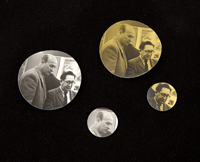JTF (just the facts): A total of 27 photographic works, variously framed and hung/displayed in the main gallery space and entry area. All of the works are constructed from gelatin silver prints, offset prints (both black and white and color), or negatives, made between 1970 and 1975. The finished works include wooden coins and balls, buttons, puzzle pieces of various kinds, a paper polyhedron, stereo photographs, phenakistoscope and zoetrope images, peel and stick photographs, polka dots, flip books, and images with included sounds. Some of the works are displayed in vending machines (the works held in blue plastic balls), while others are collected in a single vitrine. Edition sizes range from unique works to as many as 50, with some available in editions of 4, 6, 8, 9, 10, 12, or 25. (Installation shots below.)
- Comments/Context: In the past few years, Higher Pictures has quietly developed a reputation as a venue interested in the interdisciplinary edges of photography. With solo shows of new work by Letha Wilson, Kate Steciw, Joshua Citarella, Travess Smalley, and Artie Vierkant, as well as group shows gathering together an even broader array of boundary extenders (particularly in the digital realm), the gallery has made itself a home for the contemporary photographic image object, and been consistently willing to explore the evolving definition of the medium, from sculptural presence and digital mark making, to Photoshop manipulation and appropriated digital collage.
Part of the gallery’s exhibition program has also been an effort to provide some context for this new revolution, by offering historical examples of related artistic ideas; if you are interested in Travess Smalley’s recent scanner-based constructions, then perhaps Shelia Pinkel’s color photocopy works from the 1970s are also worth understanding, either as precedents, influences, or simply as artworks traveling a similar/parallel road. This eclectic show of Charles Swedlund’s photographic objects from the 1970s follows in a similar vein; if you are intrigued by digital printing on canvas, vinyl, concrete, carpet, shower curtains, and molded plastic, and what it might mean in terms of photographic art objects, then Swedlund’s conceptual experiments might provide some much needed historical background.
In many ways, Swedlund’s photographs stay close to home, albeit with a dash of Chicago Institute of Design-style photographic rigor. Female nudes (as multiple exposures, silhouettes, and set against shadowy forest backdrops) are a consistent subject, as are his wife, child, and dog, often seen as selfies taken with a round-distortion fisheye lens. As stand alone photographs, these images wouldn’t generally be durably memorable, but Swedlund’s prints were really just the beginning of a larger artistic process – from this starting point as paper, his photographs were then transformed into a dizzying array of physical manifestations, becoming both playfully interactive and conceptually sophisticated.
With an echo of Robert Heinecken’s late 1960s tiled works and twisting towers, many of Swedlund’s nudes were fragmented into puzzles. Six-sided wooden cubes were covered with parts of various nudes in nature, creating constantly shifting recreations and relationships as the cubes are rotated and reassembled. Multiple images were also broken up into square tiles for a sliding puzzle, where portions of nudes can be moved and reoriented until they ultimately coalesce into a final form. And several works take the form of traditional jigsaw puzzle pieces, as a daisy chain of arms connected by interlocked pieces or an entire image disassembled and offered in a paper bag. In each one, we see physical photographs broken down into smaller component parts that move, with images of bodies becoming barely identifiable (or abstract) limbs and torsos.
Swedlund also extended this idea of fragmentation to various other smaller scale projects that leveraged simple vending machine distribution. Horizontal slices of nudes, wooden nickels with child portraits, wooden balls with circular sections of nudes, and spinning thaumatrope nudes with two strings were sold individually, each one a piece of the larger whole or a tiny treasure, presumably to be traded and exchanged like small toys or baseball cards. Similarly intimate photographs on buttons, sticky-backed photographic polka dots, and other peel-and-stick surfaces are all examples of bringing both personal in-your-hands physicality and a casual sense of fun to his pictures.
In nearly every one of Swedlund’s projects, there is a deliberate engagement with the viewer – we are repeatedly encouraged to get involved rather than to stand aloof. There are old school stereoviews that require a special viewer, spinning zoetrope and phenakistoscope pictures that force us to bend down and peer through slits and look in mirrors, flip books that require the use of hands and fingers, negatives that require printing, and even a set of matches that are provided to burn the included photograph. It’s photography that requires conscious interaction, and that touch creates a more active, tangible (and memorable) experience of his artistic ideas.
Given the entrenched expectations (at that time, and to some extent even now) for seeing “serious” photography in print form, Swedlund’s clever photographic objects must have seemed remarkably friendly and ingenious. But their welcoming physicality hides a deeper investigation and understanding of how pictures can be transformed by different forms of interaction, and how the opposing actions of deconstruction and reconstruction help us see photographs in new ways. These mechanisms turn the act of seeing from a passive, receiving exercise into active one, and that powerful insight about photographs as objects is as relevant to today’s digital creations as it was some forty years ago.
Collector’s POV: Most of the works on view in this show are priced between $20 and $1500, with many under $500. The exceptions are the photographic cube puzzle with six prints ($25000), the photographic sliding puzzle ($15000), and the interlocking set of puzzle pieces (Buffalo, $6000). Swedlund’s work has little secondary market history, so gallery retail likely remains the best option for those collectors interested in following up.
More information available at: https://collectordaily.com/charles-swedlund-buy-photographs-not-gold-and-other-works-1970-1975-higher-pictures/

